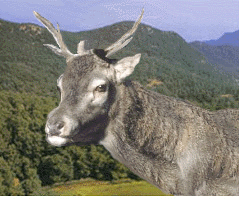...Best of Sicily presents... Best of Sicily Magazine. ... Dedicated to Sicilian art, culture, history, people, places and all things Sicilian. |
by Vincenzo Mormino | ||
Magazine Index Best of Sicily Arts & Culture Fashion Food & Wine History & Society About Us Travel Faqs Contact Map of Sicily |
The Nebrodi Mountains are so named for the deer (from the Greek nebros) that lived there in ancient times. In the Middle Ages the Normans used deer hounds, dogs similar to greyhounds, to hunt the Sicilian deer. This luxury was reserved to kings and their noble vassals. A peasant caught poaching deer might be executed. By definition, deer are antlered (rather than horned) ruminant mammals of the family Cervidae and some similar animals of the order Artiodactyla. The European species are "true" deer while some non-European species are more correctly elk. There are almost forty species of deer. The Old World deer include the families Muntiacinae and Cervidae. Among the New World deer are the families Hydropotinae and Capreolinae. As deer eat tree leaves, it is understandable that the extinction of the Sicilian deer coincided with the island's deforestation. It was primarily an environmental issue. As rivers and trees vanished so did the deer --Sicily's largest wild animals. However, over-hunting (and poaching) also played a part. The last confirmed sightings of native deer in Sicily can be dated to the middle decades of the seventeenth century in the contiguous Nebrodi, Peloritan and Etna regions, where there were extensive mountainous forests. By 1700 there appear to have been no deer left in Sicily. The wild cat and red fox survived, however. Very few Sicilian coats of arms feature deer. The lion and greyhound are much more common. This heraldic absence may indicate that the Sicilian deer population was already dwindling in the fourteenth century. Deer are also lacking in the portraiture of Sicily's aristocratic families. However, the graceful animals are carved into the wooden door of Palermo's cathedral and the stone columns of Monreale's cloister. And, of course, plenty of deer fossils have been discovered in Sicily. There have been some attempts to introduce Sardinian deer in several of Sicily's woods. (A domesticated herd can be seen in Palermo's Parco d'Orleans.) These have failed because, among other factors, effective conservation programmes require the kind of serious effort and precise objectives often lacking in Sicilian government. The deer carries all kinds of mythological symbolism. It may not have survived time, but the deer played an important part in ancient and medieval Sicilian art and literature. Its legend lives. About the Author: Vincenzo Mormino has written about wildlife and nature for Best of Sicily and hard-copy publications. | |
Top of Page |
 The interest in dinosaurs, mammoths and giant birds reflects our curiosity about fascinating but extinct creatures. Deers are hardly extinct; they live on several continents --if by various names, such as elk (called moose in North America) and caribou (the American term for wild reindeer). But, except for an effort to re-introduce non-native varieties, deer have not thrived in Sicily for several centuries. The Sicilian deer, similar to the Sardinian and Corsican deer (Cervus elaphus corsicanus), has been extinct for several centuries.
The interest in dinosaurs, mammoths and giant birds reflects our curiosity about fascinating but extinct creatures. Deers are hardly extinct; they live on several continents --if by various names, such as elk (called moose in North America) and caribou (the American term for wild reindeer). But, except for an effort to re-introduce non-native varieties, deer have not thrived in Sicily for several centuries. The Sicilian deer, similar to the Sardinian and Corsican deer (Cervus elaphus corsicanus), has been extinct for several centuries.